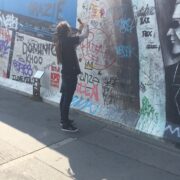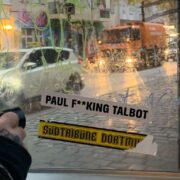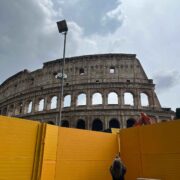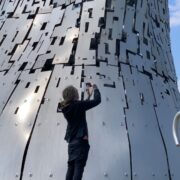Art – any art – and it’s creators are, generally, held in high regard by modern society and often thought of as being special or gifted in some way. But in this big tech, late stage capitalist hellscape that is any creative industry. The attitude towards artists would appear, at least on the surface, to be quite different these days.
Are they iconoclasts attempting to destroy human art, remove the idolatry and extinguish any value of by putting AI art tools in the hands of everyone? So that they can all become Daniel Eks next victim? Or is there another answer?
Whenever ‘they’ conquer a country ‘they’ steal the art first.
Almost daily there are reports of the destruction and looting of art and objects of cultural heritage of local, regional, national, and international significance, from all over the world. Cultural property crime is not a new phenomenon, but a tactic employed over millennia across continents and against many different cultural groups for a variety of reasons.
During WWII, the Nazis systematically looted art from occupied territories, targeting cultural treasures to assert dominance, erase cultural identities, and profit from valuable artworks.
In the modern context, AI companies are training their models on vast amounts of data, including copyrighted art, often without explicit permission from the original creators. The motive here is to develop sophisticated AI technologies that can generate new art, enhance products, and drive profit for the companies involved.
When the Nazis looted art, they often removed or obscured the provenance and original attribution, diminishing the personal and cultural significance of the works. This act of erasing identities and histories mirrors the way AI-generated art can blur the lines of authorship. Original artists may see their unique styles replicated and commodified by AI without proper credit or compensation, leading to a devaluation of their individual contributions.
The cultural loss during WWII was profound, as entire collections of significant artworks were displaced or destroyed, affecting the cultural heritage of nations. The unregulated use of artists’ work by AI also has cultural and ethical implications, as it can lead to a homogenization of art and undermine the diversity and richness of human creativity.
The key characteristic of AI’s creative processes is that the current computational creativity is systematic, not impulsive, as its human counterpart can often be. It is programmed to process information in a certain way to achieve particular results predictably, albeit in often unexpected ways. In fact, this is perhaps the most significant difference between artists and AI: while artists are self- and product-driven, AI is very much consumer-centric and market-driven – we only get the art we ask for, which is not perhaps, what we need.
AI companies have been upfront with their goal to disrupt the creative industry but they have barely been able to hide their contempt for the artists they are trying to displace.
Some firms can barely hide their disdain for the artists their product might hurt. Last month, OpenAI’s CTO Mira Murati raised eyebrows when she appeared to brush aside the seismic impact that AI could have on the job market for creatives.
“Some creative jobs maybe will go away, but maybe they shouldn’t have been there in the first place,”
Murati said at an event at her alma mater, Dartmouth College, on June 8. “You know, if the content that comes out of it is not very high quality.”
While the contexts differ significantly, and I’m certainly not saying that any of the companies or individuals involved are nazis, the core issues of power imbalance, exploitation, and cultural impact draw a parallel between the Nazi art theft during WWII and the appropriation of art by AI companies today.
Both scenarios highlight the need for vigilant protection of cultural assets and the rights of individual creators against powerful entities.
“You can wipe out an entire generation, you can burn their homes to the ground and somehow they will still find their way back. But if you destroy their history, you destroy their achievements and it is as if they never existed. That is what Hitler wants and that is exactly what we are fighting for.” – Frank Stokes.
Rise of the Robots
But it got me thinking ‘why is it always the art first?’ When AI could offer so much more in other areas like education and medicine. It could do so much good in these places and it could truly take humanity forward?
Why if you could concentrate on solving humanities biggest and most challenging problems using this amazing technological breakthrough would you simply have it draw pictures, make music and badly mimic human creativity?
Technologists pursue the development of AI to copy art and music for several reasons, each with its own set of motivations and implications.
There is significant demand for creative AI in industries like entertainment, advertising, and content creation. AI-generated art and music can be used in movies, video games, and various digital media.
AI can produce creative content quickly and at a lower cost, benefiting businesses that require a large volume of creative work.
Put simply AI could possibly be used to solve humanities greatest problems and it might at some point but, sadly, right now it’s being used by businesses to replace the creatives that ‘shouldn’t have been there in the first place’. Synthetic creativity on demand for the benefit of business and marketing.
Art intersects with issues of power
The Renaissance was marked by the rise of humanism, a movement that emphasized the value and potential of human beings, individually and collectively. Artists, through their works, embodied humanist ideals by celebrating human beauty, intellect, and creativity.
But, the Industrial Revolution and subsequent technological advancements shifted societal value towards industrial and technological achievements, sometimes at the expense of the arts. And it’s my belief that, that this disdain has become a kind of ‘industrial hangover’ that continues into the Digital Age.
So far, generative AI seems to only work, if it works at all, with human partners. Despite the futures and brave new worlds being promised by Big Tech, generative AI is still merely a sock puppet with a humans hand up its arse.
The synthetic creativity of the AI is sold as a catalyst to push our human creativity, augmenting rather than producing. It – apparently – allows us to use our creativity – our ideas – with ‘the machine’.
And whilst this promise sounds like something interesting it really is only a promise.
This is as far as AI can go.
Chat GPT isn’t really AI it’s closer to autocomplete on your phone on steroids. The copy that it churns out is – for the most part – pretty basic in writing terms. It also makes stuff up if it doesn’t know the answer – cutely referred to as ‘hallucinations’ by the tech people who want us to believe that it’s more than it really is.
Art produced using AI ‘looks’ like something that resembles art but AI can’t do simple human tasks like produce the same image with just a couple of small changes (that’s not maths, apparently) and it can’t produce various works in consistent styles without relying on copying an already established human form in the style of a prompt or filter.
As is often the case, the hype around these tools as disruptive forces outstrips the reality. Sadly – or more positively, depending on how you look at it – I don’t think that our creativity is so coveted by the unimaginative that want to use technology to remove us from our perceived lofty’ positions. I actually think it’s far worse. AI is a con and this is as good as it gets.
Big tech is has bet tens of billions of on AI being the next big thing, but what if it isn’t? What if copying Pictures and spewing out boiler plate SEO friendly text that reads like a 12 year olds homework is the BEST it can do?
ChatGPT burns obscene amounts of cash daily with little return, Google’s AI dispenses useless and sometimes dangerous advice, and a recent study showed that tech companies will soon run out of new training data to improve their AI models. If AI is really so costly, unreliable, and limited, what happens to the industry that has bet so big on it?
In a recent Podcast Adam Conover spoke with journalist and influential tech critic Ed Zitron of wheresyoured.at to discuss the impending burst of the AI bubble, the hubris of Silicon Valley, and how we suffer under big tech’s “Rot Economy.” And the news wasn’t good.
He also had some very funny insights into The real risk of A.I. and how the humans in the tech industry are going to screw the rest of us over while they chase profit.
It would appear – at least to me – that the reason for all the AI art theft is that they, like the over confident Nazi’s of WWII are slowly losing. They have overpromised and underdelivered to a stock market that will not stand for it. Zero day is coming and they’re running scared, stealing anything of value as they make a hasty retreat.
Because it seems, to a lot of experts that understand it far better than I do, that AI isn’t going to revolutionise anything anytime soon. It’s just going to be another Big Tech gimmick. Here today, gone later today.
Ideas are bulletproof. They never stop, they never die, no matter how many people you kill. – V
Ideas are bulletproof
I’m not against AI, I’m not against technology period. Today, the power to produce and publish content across platforms, whether it’s shows and movies on streaming services, photos, art and short-form videos on social media, or podcasts on audio platforms, it all lies in the hands of independent creators.
We have to accept that just like the movie makers, sound engineers and photographers whose jobs have been already been affected by the digital revolution. Tech WILL change the nature of our jobs and make it easier for anyone to get involved in whatever artistic pursuit they fancy.
You didn’t have to go to school to learn how the camera in your phone works or how to take good tattoo pictures, you didn’t go to film school to learn however to film reels either did you? And that’s just a couple creative things that we now take for granted. Things that were once someone’s ‘real’ job. A real job that tech took away.
There is more opportunity than ever for creatives to ideate and execute on artistic projects, without dealing the kinds of barriers to entry that existed only a few years ago. Just about every other creative pursuit has been being encroached on for decades now. Right now is just our turn. But they survived and adapted and so will we. Using the very technology that threatens us.
Despite what some big tech sociopaths might say, we are shortly going to become uniquely positioned to challenge the status quo once again.
The future of art is on a fast track to change even more dramatically than anticipated and while it will certainly be complex, one thing is for sure: We, the creators of ideas will have the power soon, and we’ll only wield more as time goes on.
As the truth about AI becomes known and the bubble bursts, businesses, clients and the rest of the world will – once again – have to look back to the human creatives for fresh new ideas and not the bland synthetic ‘remixes’ dished up by a calculator with an inflated ego.
Our humanity and ‘the idea’ will always be the most valuable thing we own and when they want it again, well, they’ll have to pay.
And boy oh boy, will they pay…








